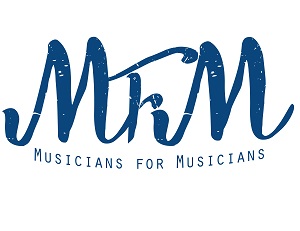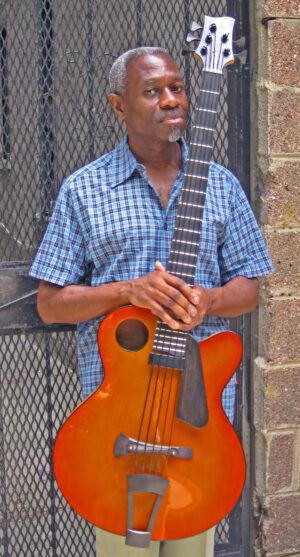Music is Essential Zoom Talk #10. Speaking on Bass: The Joys of the Bottom Line
Report by Dawoud Kringle
On Thursday, January 18th, 2024, MFM presented its tenth Music is Essential Talk. This episode was “Bass: The Joys of the Bottom Line.” The guests were MFM members bass guitarist Jerome Harris and double bassist Ron Wasserman,
MFM board member Adam Reifsteck hosted.
Jerome Harris began his professional career in 1978 as a bass guitarist for Sonny Rollins. Harris has also recorded and/or performed throughout the world (including the US, Japan, India, Africa, and the Middle East) with Jack DeJohnette, David Krakauer, Amina Claudine Myers, Bill Frisell, Paul Motian, Martha Redbone, Julius Hemphill, Ray Anderson, Leni Stern, David Amram, Don Byron, Bobby Previte, Oliver Lake, Bob Stewart, George Russell, and Roy Nathanson. He appears on more than seventy recordings. He is also a bandleader and has released albums, such as Rendezvous, On Hidden in Plain View, and Soma Code.
Harris earned a B.A. in psychology and social relations at Harvard College in 1973, Harris attended the New England Conservatory of Music as a scholarship student in jazz guitar, graduating with honors in 1977. He taught at Hampshire College, William Paterson University, Lehman College (City University of New York), and the Alternative Guitar Summit Summer Camp. His published writings include the essays Considering Jake Beard and Jazz on the Global Stage. He is the President of the Music Workers Alliance and MFMu.
Ron Wasserman has held a position as principal bassist of the New York City Ballet Orchestra since 1988 and worked as an arranger, composer, conductor, bandleader, curator, videographer, and songwriter. While primarily a classical musician, he is proficient in Jazz, Nuevo Tango, Bluegrass, several world music styles, and commercial genres. He subbed with the New York Philharmonic for 10 years, playing under the greatest conductors of the day, toured with noted tango bandoneonist JP Jofre for several years, and arranged/transcribed works by Wayne Shorter, Solange Knowles, Astor Piazzolla, and many others.
He conducted the NYC Ballet Orchestra, the Kennedy Center Orchestra, and smaller groups. His 17-piece jazz orchestra, The New York Jazzharmonic, has played in concerts as well as for the dance at the Joyce Theater, Symphony Space, and Washington Square Music Festival. Wasserman has several recordings of original music to his credit, and composed pieces for solo piano, orchestra, and jazz big band. During the pandemic shutdown, Ron was asked by the musicians and the dancers of the New York City Ballet to direct and produce two dance videos. The resulting Curbside Nutcracker, and Backstage Pass: Carnival of the Animals, became viral hits.
After Reifsteck offered an opening introduction to the Talk, he turned it over to Harris and Wasserman. Wasserman offered a gentlemanly deference to Harris to open the discussion. Harris responded to the gesture in a similar gentlemanly fashion, establishing a mutual professional and personal respect between the two master musicians. Harris started by asking if any of the other attendees were bassists. Ironically, they were not. This provided an interesting setting in that non-bassists were in attendance to acquire knowledge on the function and essence of an instrument they know of from a peripheral perspective.
Harris mused that many musicians consciously respond to the upper registers (above 500hZ). They are melody-oriented but respond on a more subconscious level to what the bass is doing.
Wasserman mentioned that as a bassist, he tends to focus on the harmony and what chord is being played (this reminded me of something Frank Zappa once said; “I like bass players who occasionally let me know what key we’re playing in.”). Harris and Wasserman spoke a bit about what initially attracted them to the bass, musing on the musical side of their upbringing.
As the talk went on, Harris and Wasserman spoke about the nature of the bass and its function within a musical environment.
At one point, Harris held forth about the function of the bass obstinate and gave some examples of how it works in its context (using Bach, Chic, and John Coltrane as examples). Wasserman talked about how classical bassists struggle with intonation. He also pointed out how the bass is always involved in propelling the music. Michael Walsh asked Wasserman about the difference between upright and electric bass. He explained some of the differences, from the perspective of a classical bassist. Harris added his thoughts about the technical and mechanical challenges of fretless vs fretted instruments, with Wasserman occasionally interjecting. Much of this centered around intonation problems.
Mike Walsh, one of the participants, asked about inventing bass parts. This set off a lengthy discourse about all the needs and possibilities of how the bass functions in the context of any music.
As the discussion progressed, Harris and Wasserman brought up an amazing variety of knowledge and insight into every aspect of the bass and its musical role. It was like a miniature masterclass. It was also quite obvious that their experience with multiple musical environments and playing other instruments gave the two a subtlety of knowledge that allowed them to not only possess a superior body of knowledge but also effectively teach and demonstrate their expertise.
This was yet another excellent presentation of MFM’s resources for the music world.

